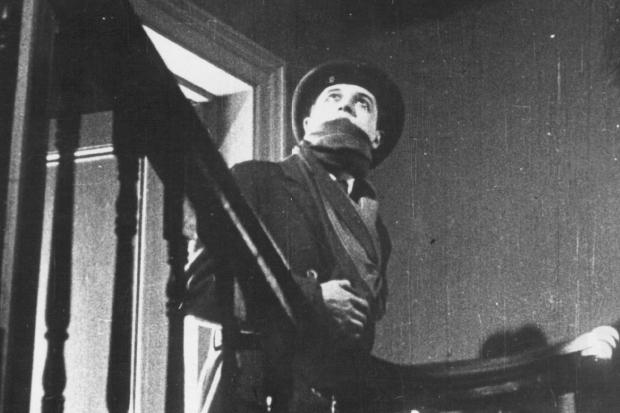The Whitechapel Fiend is a psychic conduit for the vilest aspects of Victorian sex and class, and a creature mainly of the imagination. In 1888, the year of the murders, John Francis Brewer published The Curse Upon Mitre Square, and novels have followed from such writers as Edgar Lustgarten, Colin Wilson and Iain Sinclair. Many are Ripper mash-ups in the style of Robert Louis Stevenson or Arthur Conan Doyle, as in the Holmes capers of Ellery Queen and Michael Dibdin.
Marie Belloc Lowndes’s The Lodger was made into a film by Alfred Hitchcock, A Story of the London Fog (1927), starring Ivor Novello as a sympathetic Ripper; and he features in many other films — in This is Spinal Tap (1984), for example, as the subject of Saucy Jack, a projected rock opera. From Hell (2001), named from the given address of one of the Ripper’s letters and starring Johnny Depp, was adapted from the graphic novel by Alan Moore and Eddie Campbell. He has appeared in musicals, plays and operas (Lulu), on television in Star Trek and Babylon 5, in songs by Dylan, Morrissey and Nick Cave, and in video games.
Less interestingly, perhaps, Jack the Ripper is a historical figure, and the subject of many non-fiction books. Bruce Robinson has read them all, yet in the publicity photograph for They All Love Jack he still looks fairly sane. This may be because he thinks they’re all bollocks. ‘Ripperology’ is ‘an expulsion of syncopated crap masquerading as history’. That’s what one wants from the writer and director of Withnail and I, and his new book abounds in choice insults: ‘treacherous buffoon’, ‘fat little parasite’, ‘hopeless lickspittle’, ‘vainglorious oaf’. It’s also quite sweary, and Withnail’s Danny the Dealer supplies the epigraph for one of its chapters. Still, as he concedes, ‘I think it’s desirable not to get too intoxicated with one’s own invective.’
Robinson begins his investigation with the question of why Jack the Ripper was never caught, and does not hesitate to supply the answer. He was not caught because the entire apparatus of the ruling class — the royal family, aristocracy, politicians, judiciary and police — did not want him to be, and did everything in its power to protect him. The Ripper was ‘a killer in a killer state’, a psychopath ‘shielded by servants of the Victorian state’.
‘Any smart copper,’ he writes, ‘could have stopped this catastrophe in its tracks.’ In 1888, when Jack was playing what he called his ‘Funny Little Game’, the Metropolitan Police Commissioner was Sir Charles Warren, who Robinson presents as ‘the world’s most wilfully blind policeman’. Twenty years earlier he had excavated the Dome of the Rock in Jerusalem, where he established the Reclamation Lodge of Jerusalem, before amending its name to Warren’s Masonic Hall.
In the cutting open of pockets and removal of metal objects, the slit throats and eviscerations, with the bowels thrown over the shoulder, the Ripper’s filthy work offered perverted echoes of Masonic ritual. After the murder of Catherine Eddowes, generally reckoned the fourth victim, a message was chalked on a wall, with a piece of Eddowes’s bloodied apron left beneath it: ‘The Juwes are the men that will not be blamed for nothing.’ It was washed off on Warren’s orders, supposedly for fear of inflaming feeling against local Jews. But in the case of Mary Jane Kelly, the last of the ‘canonical five’ victims, Warren took the opposite approach, officiously detaining every Jew in the vicinity.
Kelly was subjected to unspeakable rites involving fire and bones, evidently inspired by Ezekiel xl, a key text in Freemasonry, and Robinson argues that the ‘Juwes’ graffito, the most important piece of evidence in the murders, refers to the punishment of the three assassins Jubela, Jubelo and Jubelum, who are said to have killed Hiram Abif, Freemasonry’s first Grand Master, in Solomon’s Temple (i.e. the Dome of the Rock). Would Warren, ‘one of the world’s leading Masonic historians’ and the refounder of Solomon’s Temple, have been deaf to all these echoes?
Robinson thinks not. The Ripper, who had ‘a witty and macabre sense of fun’, was teasing the police, while Warren and his fellow members of a ‘self-regulating occult matrix’, such as Sir Robert Anderson, chief of the CID, who ‘could lie like a back-alley slut, and was up to his dandruff in a clandestine duplicity’, conspired to cover up the Masonic credentials of the perpetrator.
Robinson has a candidate, Michael Maybrick, a popular musician whose compositions include ‘They All Love Jack’, and presents a mountain of evidence to back his claim. And not content with one conspiracy, he ties the Ripper case to several more, chiefly the notorious murder trial of
Florence Maybrick, Michael’s sister-in-law. It’s an impressive performance, passionately argued, overwhelmingly convincing while one’s reading it, and more than a little mad.






Comments